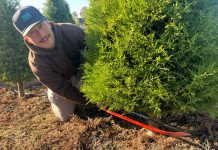Rediscovered painting of Henry Coe shows cattleman at work in
hills that would be named for him
For years it graced the wall of a bar, a vision of oaks and
cattle for thirsty Madrone pioneers.
Now a painting by one of Santa Clara County’s premier artists of
Henry W. Coe, the man for whom the state park is named, is
scheduled to return to the public domain this fall after being in
private hands for the better part of a century.
Rediscovered painting of Henry Coe shows cattleman at work in hills that would be named for him
For years it graced the wall of a bar, a vision of oaks and cattle for thirsty Madrone pioneers.
Now a painting by one of Santa Clara County’s premier artists of Henry W. Coe, the man for whom the state park is named, is scheduled to return to the public domain this fall after being in private hands for the better part of a century.
The 5×3-foot oil, executed in 1904 by Andrew P. Hill, depicts a cattle drive in which Henry Coe and his brother, Charles, are herding livestock across a creek somewhere in the vicinity of where the Anderson Reservoir dam now blocks the mouth of the canyon.
The exact location is not known. But Jack Kirby, 81, of Tres Pinos, a nephew of saloon owner Patrick Kirby, thinks the scene was near the confluence of Coyote and Las Animas creeks, where an early-day resort was located. The area is now under water.
“I remember my dad talking about the location,” Kirby said.
Now being restored in Watsonville by recognized art conservator Alejandro Reyes-Vizzuett, the painting has been donated to Coe Park by Gayle and Adolph Wagner of Redwood Valley. Gayle Wagner is the granddaughter of Patrick Kirby, a pioneer innkeeper in Madrone — now a northern Morgan Hill neighborhood — who had the Hill work hanging behind his bar for years.
Once restored, the painting will be exhibited in the Coe Park visitors’ center high atop Pine Ridge.
No one knows how the painting depicting the Coe brothers and four other drovers, one of whom is believed to be Daniel Murphy, a descendant of early-day cattle baron Martin Murphy, ended up in Pat Kirby’s saloon.
That’s not unusual, said Reyes-Vizzuett. Most owners don’t know the history of the pieces in their collection.
Eleanor Schrader, 98, one Kirby’s seven children, remembers as a child seeing the painting hanging over the bar, which connected to the grocery store where she clerked.
“I’m so happy that it’s going to have a good home,” said Schrader, now a resident of Scott’s Valley, who knew members of the Coe family as a girl.
Time and travel have not been kind to the painting. The canvas, which crumbles to the touch, is cracking in various places as a result of exposure to dust, smoke, grease and soot, the absence of humidity control and the gradual loosening of the stretcher bars that are supposed to keep the canvas taut.
The fragility of the canvas necessitates a backing, a second canvas, which Reyes-Vizzuett will attach to the rear of the original with an absorbent resin. The resin will penetrate the old canvas, filling in the cracks.
The reinforced canvas will be spread over new stretcher bars to keep it taut.
“Once the maintenance is done, he said, it will be good for another 50 years at least,” he said.
An experienced eye can pick out earlier restoration of a tear or a hole on the left side of the painting among the dark-green foliage of the oaks that lined the banks of the creek.
As a courtesy for the untrained observer, Reyes-Vizzuett exposes the back of the canvas to show a vertical 8×2-inch cork patch.
Reyes-Vizzuett works in a studio detached from his Watsonville home. Also awaiting his attention is an unsigned copy of perhaps a Francisco Zubaran version of martyred Saint Agatha holding her severed breasts on a silver tray – punishment for spurning the advances of the magistrate Quinctianus. The 79×44-inch oil belongs to the Santa Ines Mission near Solvang.
In a 27-year career, Reyes-Vizzuett has restored art treasures in Mexico, Guatemala, Ecuador and several early California missions. He also has worked at San Francisco’s de Young Museum and Palace of the Legion of Honor and for the past six months has been busy at Hearst Castle.
A native of Mexico City, Reyes-Vizzuett lived as a youngster in Coyoacan, a sector of the metropolis that predates the arrival of the Spaniards. His father, Ernesto Reyes Rodriguez, operated a photography studio and took wedding photos for Mexican muralist Diego Rivera and painter Frida Kahlo.
Reyes-Vizzuett is a graduate of the National School of Conservation, Restoration and Museography in Mexico City, a five-year course that teaches restoration of murals, sculpture, ceramics and stone as well as canvas. Students take three years of chemistry to understand solvents used to clean paintings. They also learn about mold and pests such as termites that attack wood. Students alternate classroom instruction with hands-on field work in museums and libraries.
Experts sometimes can tell when an accident – such as the slash in the Coe painting – occurred, Reyes-Vizzuett said. The type of fabric, its weave or whether it was made by hand or by machine offers clues, he said. Nowadays, he added, laboratories can date a sample of paint, but the process is expensive.
Reyes-Vizzuett often juggles a series of restorations, turning to a new project when he reaches a stalling point in another. In addition to the studio restorations, Reyes-Vizzuett has spent the last six months giving new life to an Italian gilt and polychromed wooden ceiling and four tempera-on-wood paintings at Hearst Castle, where he has worked periodically since 1993.
In tackling the painting of the Coe brothers, Reyes-Vizzuett will remove the oxidized varnish, dabbing softly with a solvent-soaked ball of cotton on a stick.
“It’s a slow process and I have to cover every square inch,” Reyes-Vizzuett said.
He calculated it will take him six to eight weeks working six hours a day to finish the Coe project. He works alone, except for when he requires help to stretch a canvas.
While no one knows how Patrick Kirby came by the painting, they remember that he took it with him when he retired. The painting passed to daughter, Dorothy. She in turn gave it to niece Gayle Wagner, who found room for it in the game room of her large Ukiah home. When Gayle and her husband moved to Redwood Valley, the painting was too big for their new home.
Cousins George and Phyllis Thomas of Morgan Hill suggested that the painting, which depicted people and activities closely associated with the area, belonged in Coe Park.
The offer of the gift was enthusiastically received by rangers and volunteers at the 87,000-acre Coe Park east of Morgan Hill.
“We knew going in that the painting was a ranching scene on one of the Coe ranches,” Coe Park ranger Barry Breckling said. “But when we saw that Henry Coe and his brother, Charles, were clearly depicted, we started to realize the full significance. Then I noticed the signature of the artist, Andrew P. Hill.”
Hill was born in Indiana in 1853 and came to California with his parents via the Isthmus in 1867. He studied art at the California School of Design and took private lessons. Hill and one of his instructors opened a portrait studio in Oakland in 1876 and one in San Jose two years later. He exhibited widely, including at the 1904 World Fair in Saint Louis. He died in Pacific Grove in 1922.
The name Hill means a lot to parks people because Hill, as a well known San Jose photographer and painter, led the campaign in 1899 to save a portion of California’s coastal redwood forest. The group he organized from among educators, writers and members of women’s clubs became the Sempervirens Club, today the Sempervirens Fund.
With $32 donated by members, the club began to lobby to save the grove of trees that became Big Basin State Park in 1902. The passion Hill demonstrated is credited by many as the driving force behind the creation of the state parks system, which today includes 1.3 million acres in 270 parks. The acreage includes one-third of the California coastline.









